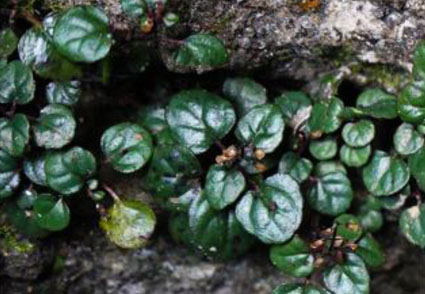Abstract
A new species of Scutellaria (Lamiaceae), Scutellaria jishouensis G. X. Chen, L. Tan & X. M. Xiang, sp. nov from Dehang Scenic Spot, Hunan Province of China, is described and illustrated. Scutellaria jishouensis is morphologically similar to S. indica and S. calcarata, but can be easily distinguished by its creeping, spreading to erect or ascending-erect, stem with forked adventitious roots; leaves membranous, sparsely crenate or entire; racemes 1-10 cm, corolla sparsely pilose or glabrous on adaxial, glabrous inside, and flowering and fruiting in late April-June. Phylogenetic analyses, based on the nuclear ribosomal internal and external transcribed spacers, showed that S. jishouensis and S. calcarata were sister species with good support. The results of both morphological data and the phylogenetic analysis support the specific rank of S. jishouensis.
References
Císarová, M., Hleba, L., Tan?inová, D., Florková, M. & Klou?ek, P. (2018) Inhibitory effect of essential oils from some Lamiaceae species on growth of Eurotium spp. isolated from bread. Journal of Microbioloy, Biotechnology and Food Sciences 8: 857–862 https:// doi.org/10.15414/jmbfs.2018.8.2.857-862
Deng, T., Zhang, D.G., Cheng, G.X., Zhu, G.Y. & He, H.S. (2010) Supplemental description and karyotype of Aspidistra fenghuangensis (Convallariaceae). Guihaia 30: 166–169+214.
Du, T.T., Xiao, Y., Cheng, G.X. & Liu, Y.D. (2013) A new species of Dryopteris (Dryopteridaceae) from Hunan, China. Life Science Research 17: 412–414.
Hall, T. A . (1999) BioEdit: A user-friendly biological sequence alignment program for Windows. Nucleic Acids Symposium Series 41: 95–98.
IUCN (2019) Guidelines for using the IUCN Red List categories and criteria. Version 14. Prepared by the Standards and Petitions Committee, Cambridge U.K. Available from: https://www.iucnredlist.org/resources/redlistguidelines (accessed 8 January 2022).
Li, D.Z., Chen, Z.R. & Wang, H. (2020) Lamiaceae Martinov (1820), nom. cons. Genera and families of vascular plants from China. Science Press, Beijing, pp. 2010–2055.
Li, S.Y. & Li, C.Y. (2016) Developmental plasticity of plant roots. China Basic Science 18: 14–21.
Li, W.P. & Liu, S.X. (2002) Aster jishouensis (Asteraceae), a new species from Hunan, China. Journal of Systematics and Evolution 40: 455–457.
Mehalaine, S. & Chenchouni, H. (2021) New insights for the production of medicinal plant materials: ex vitro and in vitro propagation of valuable lamiaceae species from northern africa. Current Plant Biology 27: 100216. https://doi.org/10.1016/j.cpb.2021.100216
Paton, A. (1990) A global taxonomic investigation of Scutellaria (Labiatae). Kew Bulletin 45: 399–450 https://doi.org/10.2307/4110512.
Perrino, E.V., Valerio, F., Jallali, S., Trani, A. & Mezzapesa, G.N. (2021) Ecological and Biological Properties of Satureja cuneifolia Ten. and Thymus spinulosus Ten.: Two Wild Officinal Species of Conservation Concern in Apulia (Italy). A Preliminary Survey. Plants 10: 1952. https://doi.org/10.3390/plants10091952
Rédei, G.P. (2008) CLUSTAL W (improving the sensitivity of progressive multiple sequence alignment through sequence weighting, position-specific gap penalties and weight matrixchoice). Springer Netherlands 4673–4680.
Ronquist, F., Teslenko, M., van der Mark, P., Ayres, D.L., Darling, A., Hohna, S. & Huelsenbeck, J.P. (2012) MrBayes 3.2: Efficient Bayesian phylogenetic inference and model choice acrossa large model space. Systematic Biology 61: 539–542. https://doi.org/10.1093/sysbio/sys029
Seyedipour, S., Salmaki, Y. & Xiang, C.L. (2020) Molecular phylogeny of Scutellaria (Lamiaceae; Scutellarioideae) in Iranian highlands inferred from nrITS and trnL-F sequences. Progress in Biological Sciences 7: 169–181.
Stamatakis, A. (2014) RAxML version 8: a tool for phylogenetic analysis and post-analysis of large phylogenies. Bioinformatics 30: 1312–1313. https://doi.org/10.1093/bioinformatics/btu033
Thiers, B. (2022) Index Herbariorum: A global directory of public herbaria and associated staff. New York Botanical Garden’s Virtual Herbarium. Available from: http://sweetgum.nybg.org/science/ih/ (accessed 8 January 2022).
Vaidya, G., Lohman, D.J. & Meier, R. (2011) Sequence matrix: concatenation software for the fast assembly of multi-gene datasets with character set and codon information. Cladistics 27: 171–180. https://doi.org / 10.1111/j.1096-0031.2010.00329.x
Valerio, F., Mezzapesa, G.N., Ghannouchi, A., Mondelli, D., Logrieco, A.F. & Perrino, E.V. (2021) Characterization and antimicrobial properties of essential oils from four wild taxa of Lamiaceae family growing in Apulia. Agronomy 11: 1431. https://doi.org/10.3390/agronomy11071431
Wang, X.W. & Xue, Z.W. (1984) A new species of Scutellaria from Anwei province. Guihaia 4: 201–202.
Xiang, X.M., Tan, L., Liu, B. & Cheng, G.X. (2020a) Study and prospect of plant diversity in Dehang Scenic area of Hunan province. Journal of Jishou University (Natural Sciences Edition) 41: 45–51.
Xiang, X.M., Wang, B.Z., Zhang, J.Y., Zhang, D.G. & Cheng, G.X. (2020b) Quercus dehangensis : a new species of Quercus (Fagaceae) from Hunan Province, China. Acta Botanica Boreali-Occidentalia Sinica 40: 1778–1783. https:// doi.org/10.3897/phytokeys.182.71063
Xu, L.L., Wang, H., Gao, P.P., Wu, S.Q. & Yang, Z.L. (2020) Effects of environmental stress on plant root morphology. Journal of Anhui Agricultural Sciences 48: 16–19.
Zhang, D.G., Liu, Y. & Yang, Q.E. (2008) Sinosenecio jishouensis (Compositae), a new species from north-west Hunan, China. BotanicalStudies 49: 287–294. https://doi.org/1817406X-200807-49-3-287-294-a
Zhao, F., Liu, E.D., Peng, H. & Xiang, C.L. (2017) A new species of Scutellaria (Scutellarioideae, Lamiaceae) from Sichuan Province in southwest China. PeerJ 5: e3624. https://doi.org/10.7717/peerj.3624


